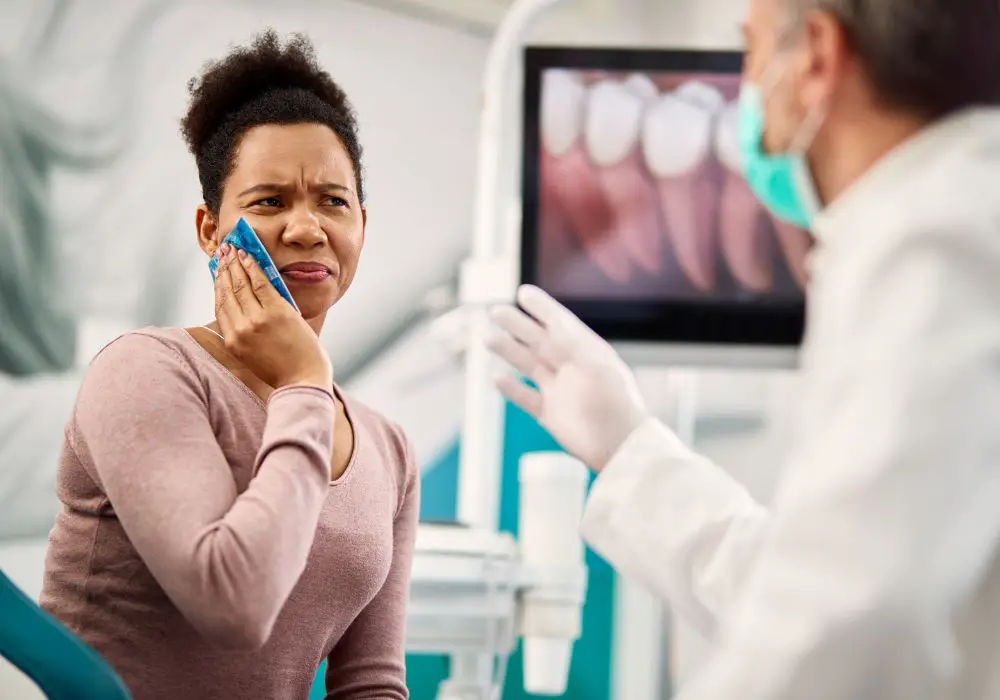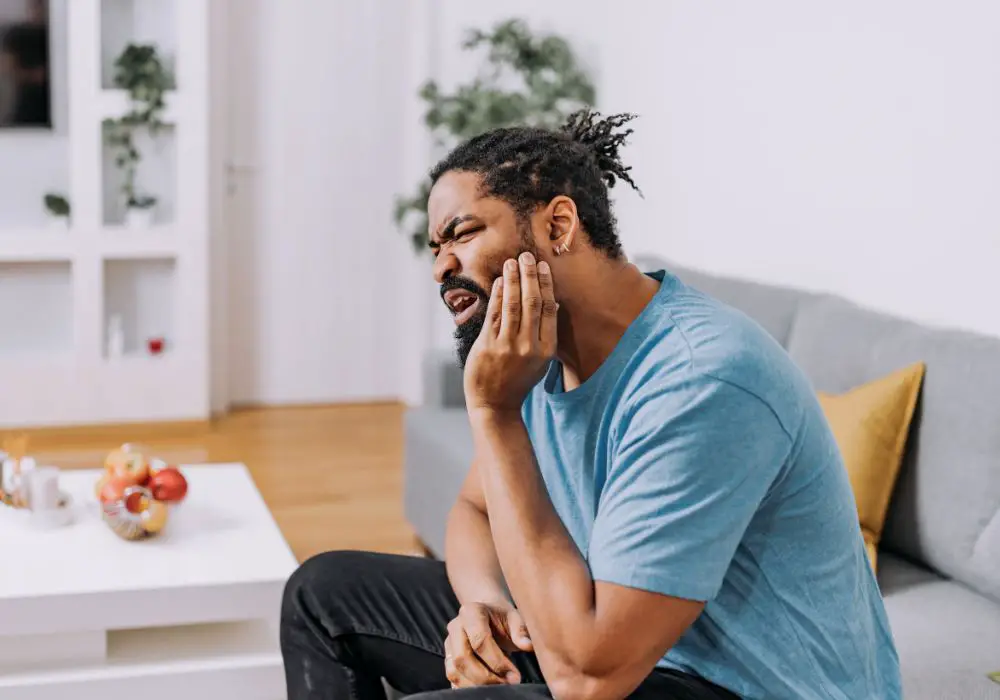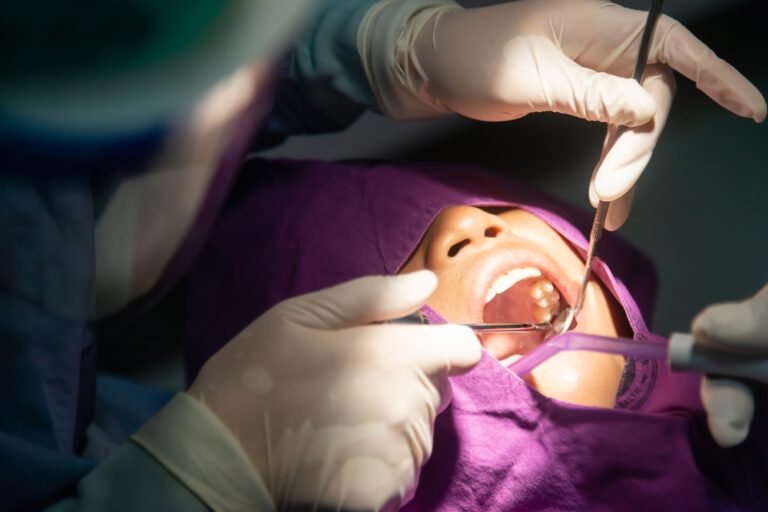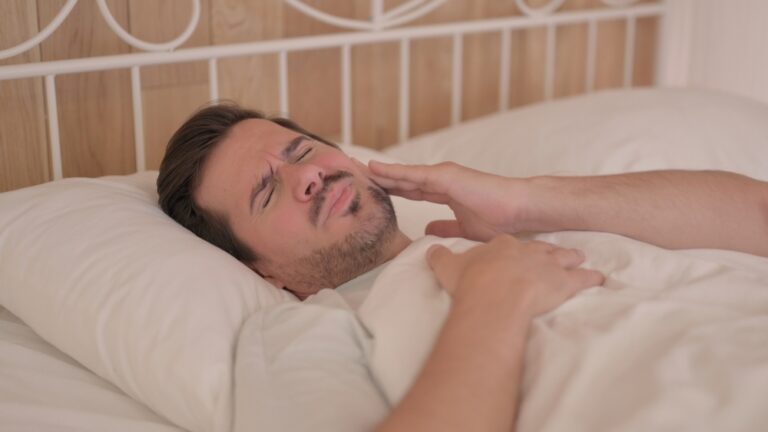Having a toothache when eating or drinking can be very painful and make daily activities difficult. A bad tooth that hurts during eating is often decayed and inflamed, but other dental issues like cracked or loose teeth can also cause pain. Understanding the common causes of tooth pain when eating can help you get the right treatment to relieve your discomfort.
What Causes Tooth Pain When Eating?

There are several potential causes of tooth pain when consuming food or drink:
Tooth Decay
Tooth decay, also called dental caries or cavities, is a breakdown of the tooth structure. It’s caused by bacteria in the mouth creating acid from food debris and sugar. This acid eats away at the enamel and dentin, creating holes in the teeth.
As the decay gets closer to the inner pulp of the tooth, heat, cold, sweet foods, and pressure can trigger pain. Cavities typically start small but expand over time. A dentist needs to remove decayed material and fill the hole to stop further damage. Extensive decay under a filling or large cavities can mean a root canal is required.
During a root canal, the dentist drills into the tooth pulp, removes the infected tissue and bacteria inside, and seals it off. The empty canal is filled and the tooth sealed with a crown. Root canals are done when the decay has compromised too much tooth structure or caused inflammation of the pulp. They relieve pain by removing the irritated nerve and pulp.
Dental Abscess
A dental abscess is a pocket of pus caused by a bacterial infection in the tooth’s pulp or gum tissues. Abscesses are often connected to advanced tooth decay but can also result from cracked teeth, trauma, or failed root canals. The buildup of pus puts pressure on the tooth, causing throbbing pain, swelling, and sensitivity.
Abscesses require a root canal or tooth extraction to drain the infection. The dentist will make an incision to release the pus, rinse the area thoroughly, and treat the infected tooth. Antibiotics may also be prescribed to clear bacteria from the bloodstream. Until treated definitively, hot and cold foods can irritate the abscess.
Cracked or Broken Tooth
Cracks or fractures in a tooth may cause discomfort when biting or chewing. The crack allows bacteria, food, and air to enter the tooth layers, irritating the inner pulp. Vertical cracks are most concerning as they can extend down through the root.
Small hairline cracks can sometimes be repaired with fillings or crowns. The dentist will clean out the crack, fill it with composite resin or other material, and seal the tooth. Larger cracks likely require a root canal and crown placement to hold the tooth together if it can be saved. Badly broken teeth usually need extraction.
Loose Teeth
Teeth can become loose from advanced periodontal (gum) disease, trauma, or injury. When teeth loosen, they may ache, especially when pressure is applied during eating. Food and particles also get trapped more easily, causing further irritation.
Gently cleaning the area and using pain medicine can provide some relief. But loose teeth need to be examined and stabilized quickly to avoid additional damage or tooth loss. Dentists will look for signs of infection like abscesses, gum inflammation, and bone loss around loose teeth. They may be able to splint the teeth to prevent movement, or in severe cases, extraction may be required.
Damaged Dental Work
Existing dental work like fillings, inlays, crowns, and bridges can fail over time and become damaged. This allows bacteria to get underneath and infect the tooth. Chewing puts added stress on these restorations that can cause pain if they are cracked, loose, or leaking.
Failed restorations need replacement to seal areas where bacteria are entering and irritating the inner tooth. If a crown comes off, the inner core could fracture and become reinfected. Loose fillings also allow decay to spread. Your dentist will remove old restorations and redo any dental work causing discomfort.
Root Sensitivity
Root sensitivity is a common problem that makes teeth hurt from hot or cold foods and drinks. It’s caused when the gum line recedes and exposes the root surfaces. These areas lack protective enamel coating and have tiny openings to the inner pulp.
Exposure to different temperatures, sugars, and pressure sends pain signals from these openings to the nerve. Desensitizing toothpaste, fluoride gels, sealants, and sometimes gum grafting procedures can help reduce root sensitivity. Proper brushing technique is also key to prevent further gum recession.
TMJ Disorders
Temporomandibular joint (TMJ) disorders affect the jaw joints and muscles controlling chewing. Issues like arthritis, misalignment, and clenching/grinding can damage the TMJ. This leads to inflammation, muscle spasms, and pain that makes chewing difficult.
Symptoms may come and go and range from mild to severe. TMJ disorders are typically treated first with conservative therapies like anti-inflammatory medicine, mouth guards, physical therapy, massage, and icing. Orthodontics or oral appliances may also help realign the bite. Surgery may be considered for persistent cases that do not improve.
Sinus Infections
The upper back teeth sit below your sinus cavities. So infections and inflammation in the sinuses from colds, allergies, or other irritants can put pressure on those teeth. This radiating pain is often dull and throbbing.
Sinus tooth pain is usually accompanied by other symptoms like congestion, runny nose, sore throat, and general headache. Treatment involves clearing the sinus infection with antibiotic or antihistamine medications. Nasal decongestant sprays, steam, gentle heat, and nasal irrigation can also provide relief. In severe cases, surgery may be required.
When to See a Dentist

You should make an appointment with your dentist if you have a tooth that hurts when eating or biting down. While you can take over-the-counter pain relievers as needed, only a dentist can diagnose and properly fix the source of the problem.
See a dentist right away if you have:
- Severe, sharp pain that is prolonged and radiates to your ear, jaw, or head
- Swelling in your gums or face
- Bleeding from the tooth
- A tooth that is very sensitive to hot or cold
- A tooth that is cracked, damaged, or feels loose
- A bad taste or odor coming from the tooth
- Unexplained tooth pain that interferes with eating and sleeping
Leaving tooth pain untreated risks additional infection and damage, tooth loss, and the spread of bacteria that could lead to abscesses or a systemic infection. It’s important to seek help promptly for evaluation and treatment.
Diagnosis of Tooth Pain When Eating
During your dental visit for tooth pain while eating, the dentist will:
- Ask questions about your symptoms, when they started, and what provides relief
- Look for clinical signs like swelling, redness, bleeding, drainage, or damage
- Examine the tooth roots and surrounding gum tissues
- Check for loose teeth, cracks, cavities, or defective dental work
- Tap lightly on teeth to test for sensitivity and pain response
- Apply controlled hot, cold, and pressure to evaluate reactions
- Use an explorer instrument to check for soft decay spots
- Test pulp vitality with electrical stimulation or cold spray
- Take dental x-rays to visualize below the tooth surface for problems
This comprehensive oral exam allows the dentist to determine the cause of pain and recommend appropriate treatment. Details like whether the pain lingers after a stimulus is removed can be very helpful for diagnosis. The dentist will also review your medical history for any medications, conditions, or risk factors that could be contributing to the tooth pain.
Treatment Options for Tooth Pain When Eating

The dentist will suggest treatments based on the exam findings and origin of your tooth pain. Common treatment approaches include:
Treating Cavities
Small cavities may only need a simple filling to remove decay and prevent sensitivity. The dentist uses a drill to clear out the cavity then fills it with composite resin, silver amalgam, or another filling material to seal it.
More advanced decay requires further drilling to access the tooth pulp and nerve followed by root canal treatment. The empty canals are filled and sealed, and a crown is placed to restore the tooth.
Draining Dental Abscesses
Abscesses must be opened and drained by a dentist to eliminate the infected material. This is often combined with root canal therapy or tooth extraction if the tooth cannot be saved. The dentist will make an incision to release pus and rinse the area thoroughly. Antibiotics may also be prescribed.
Stabilizing Cracked or Loose Teeth
Minor cracks in teeth can sometimes be repaired with fillings or crowns. Splinting loose teeth helps prevent further movement. But significant cracks or damage usually means extraction is required.
For restorable cracked teeth, the dentist first cleans out the crack then seals it with filling material. A crown is often placed to strengthen the tooth. Loose teeth are stabilized by bonding or wiring them to stable neighboring teeth.
Replacing Old Dental Work
Failed or defective restorations like fillings, inlays, crowns, and bridges need replacement to seal areas where bacteria are entering. An ill-fitting crown can mean the inner tooth fractured. Loose fillings also allow decay to spread. Your dentist will remove and redo any problematic dental work.
Treating Root Sensitivity
Gentle brushing and desensitizing toothpaste can help reduce mild root sensitivity. For more severe cases, dentists may apply stronger fluoride, adhesive sealants or recommend fillings if the pulp chamber is exposed. Gum grafting also helps cover exposed roots.
Relieving TMJ Pain
TMJ pain management starts with conservative treatments like anti-inflammatory medicine, heat/ice, a soft diet, jaw rest, physical therapy, and bite guards. Botox injections, orthodontics, oral appliances, or surgery may be considered for persistent TMJ disorders.
Clearing Sinus Infections
Sinus infections require prescription antibiotic or antifungal medications to clear infection. Nasal sprays, antihistamines, decongestants, irrigation, and nasal steroid sprays provide additional relief. In severe refractory cases, surgery opens the sinus cavities for drainage.
In addition to active treatments, your dentist can advise dietary changes to prevent certain foods and drinks from aggravating your tooth pain during recovery. Proper oral hygiene is also critical to allow tissues to heal after invasive dental treatments.
Home Remedies to Soothe Tooth Pain When Eating
While you wait to see a dentist, you can try some temporary relief measures at home:
- Over-the-counter pain medicine – Anti-inflammatories like ibuprofen or acetaminophen can relieve sensitivity. Use as directed.
- Cold compress – Applying an ice pack or cold cloth cools the area to numb pain. Do not place directly on skin.
- Salt water rinse – Mix 1 tsp salt in a cup of warm water and swish to draw out fluid and soothe inflamed tissues.
- Dental wax – Seal off irritated areas temporarily from air exposure with wax.
- Avoid certain foods – Stay away from very hot, cold, sweet, or hard foods that trigger pain.
- Bite on cotton – Place a small cotton ball or gauze directly over the painful tooth while eating to minimize pressure.
- Proper oral hygiene – Gently brush and floss to keep the area clean but take care around inflamed gums.
These remedies only provide temporary relief for tooth pain. See your dentist as soon as possible for an exam and definite treatment to resolve the underlying problem.
When to Seek Emergency Dental Care
Seek emergency dental treatment immediately if you have:
- Uncontrolled bleeding from the mouth that doesn’t stop
- Difficulty breathing, swallowing, or opening your mouth
- Severe swelling in the mouth, jaw, or neck areas
- Trauma causing tooth fractures, displacement or loss
- Facial bruising or palpated broken bones
- Sudden, spontaneous, radiating, or persistent toothaches
Many dental clinics provide emergency out-of-hours services and can see you promptly. They have access to imaging equipment and specialists who can diagnose and stabilize dental emergencies. Prompt care helps avoid complications and lasting damage from issues like infections, fractures, or abscesses.
Prevention Tips to Avoid Future Tooth Pain

You can minimize tooth sensitivity and pain when eating by taking these preventive measures:
- Brush gently twice a day and floss once daily to prevent decay and disease.
- Replace your toothbrush every 3-4 months when bristles appear frayed.
- Use antimicrobial toothpaste to protect against plaque.
- Rinse your mouth with water after meals and sugary snacks.
- Avoid constant snacking and limit acidic drinks like soda that erode enamel.
- Wear a custom night guard if you grind your teeth.
- Quit smoking and tobacco use which raises decay and gum disease risks.
- Get regular dental cleanings and exams every 6 months.
- Have any cavities filled quickly before they enlarge and require root canals.
- Discuss any tooth sensitivity right away so potential issues can be caught early.
Proper oral hygiene and care help protect your teeth and avoid problems that can cause pain with eating. Tell your dentist about any temperature sensitivities or discomfort right away so they can be addressed before turning into major issues.
Frequently Asked Questions
Why does cold water hurt my tooth?
Cold sensitivity is common with tooth decay under old fillings or sealants, cracks, and receding gums that expose the root surfaces to stimuli. The fluid change irritates the inner pulp and triggers pain signals.
What’s the difference between a regular filling and a root canal?
Fillings remove decay and seal holes in teeth with minimal drilling. Root canals are done when decay reaches the inner pulp; they clean out infected pulp tissue and seal the interior canals. Root canals require more extensive drilling and are often followed by a crown.
Can a sinus infection really cause tooth pain?
Yes, sinus infections from colds, allergies, air pressure changes, or other irritants can radiate pain and pressure to the upper back teeth below the sinuses. See your dentist to rule out dental causes. Antibiotics, decongestants, nasal irrigation, and antihistamines clear sinus infections.
When is a tooth extraction absolutely necessary?
Extractions are usually necessary if the tooth is severely decayed and cannot be restored with other treatments. Cracked teeth split below the gumline, severe gum disease, advanced periodontal infections, and traumatic fractures also often require tooth removal.
What are dentists looking for during an exam for tooth pain?
The dentist will check thoroughly for visual signs of damage, decay, infection, gum recession, cracks, worn restorations, and more. They will also feel for looseness, tap teeth to check sensitivity, apply temperature and pressure tests, and take x-rays to make a diagnosis.
Conclusion
Tooth pain when eating that persists indicates an underlying problem needing prompt professional care. Issues like tooth decay, cracks, gum infection, dental work damage, and more can cause sensitivity when chewing or biting down. Only a dentist can properly diagnose the cause of discomfort and provide definitive treatment to resolve the problem. Proper treatment will allow you to restore dental function and be able to enjoy eating again comfortably.






